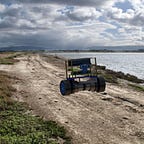After many attempts to build my initial stabilisation attachment I accepted the manufacturing of the front axel design on this small scale would be tedious, complex and would result in an over engineered part. I therefore went back to the drawing board to plan my next idea.
The first thing I did was to practically test if a single front support would give enough stability to the robot during cornering and other tasks.
Using a AA battery I supported the front tray and placed weight at each corner to simulate the forces of turning. I found this would be adequate and so i found a caster wheel that was the correct height and wider than the normal caster wheels giving a stout and stable base.
Next in my stabilisation design I decide to take inspiration from drag racing as the caster wheel holds the robot in a level position and any accelerating force will cause the robot to fall backwards.
In order to create the wheelie bar I repurposed a roller from a hoover head using a custom metal bracket I manufactured specifically to work in this manner. I first created a cardboard model of the bracket. This allowed me to adjust and change parts of the bracket easily and with no expense.
